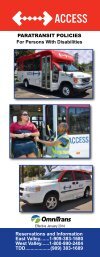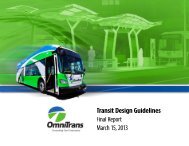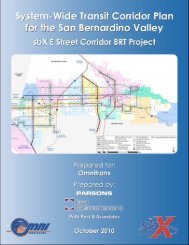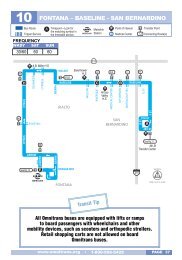Short Range Transit Plan 2008-2013 - Omnitrans
Short Range Transit Plan 2008-2013 - Omnitrans
Short Range Transit Plan 2008-2013 - Omnitrans
You also want an ePaper? Increase the reach of your titles
YUMPU automatically turns print PDFs into web optimized ePapers that Google loves.
IBI GROUP<br />
SHORT RANGE TRANSIT PLAN REPORT<br />
OMNITRANS COMPREHENSIVE OPERATIONAL ASSESSMENT<br />
& SHORT RANGE TRANSIT PLAN<br />
Priority Needs – The following is a brief listing of the unmet needs in order of priority:<br />
Base Route Structures, Frequencies and Spans – The first priority need is to improve the base routes as<br />
they serve the major corridors and markets and are the foundation of the grid system in the East and<br />
West Valleys. Consideration needs to be given to: restructuring several base routes to improve their<br />
coverage and travel time; connecting Routes 14 and 66 with a limited stop service to have uninterrupted<br />
and faster service in the Foothill corridor; extending Route 62 north into North Upland to have<br />
uninterrupted service in the Euclid corridor and south into South Chino to serve the new Chaffey College<br />
campus and Chino Hills; and extending Route 67 west in the Baseline corridor to serve Montclair. Routes<br />
2, 14, 22, 61 and 66 provide 15-minute service which should be the target headway for all base routes;<br />
Routes 3/4 provide 20-minute service, which needs to be upgraded to 15-minutes for consistency<br />
purposes. Route 10 has the demand to justify 15-minute peak service. Routes 2 and 14 have the loads<br />
to justify better than 15-minute service, which would be achieved by operating limited stop or sbX-type<br />
services in the E Street (Route 2) and Foothill (Routes 14 and 66) corridors. Consideration needs to be<br />
given to improving the spans on Route 10 and 67, which are below standard. Improving the base route<br />
structures, frequencies and spans will increase the daily revenue hours by about 250 revenue hours. The<br />
estimated unmet demand for these improvements is 6,000 daily passenger trips.<br />
Local Route Structures, Frequencies and Spans – There is a need to improve the structure of some of the<br />
local routes to improve their performance, reduce the wait and travel times to the main destinations in the<br />
local areas, and provide service into unserved areas. In the East Valley, it would include straightening<br />
and extending Routes 8 and 9 into north and south Yucaipa, straightening and extending Route 15 into<br />
central Redlands to replace Route 31, adding new routes in the San Bernardino Ave East and Sterling<br />
corridors, and extending Route 29 into the Merrill and Cherry/Beech corridors. In the West Valley, it<br />
would include extending the section of Route 60 west of Chaffey College to the Ontario Transcenter in the<br />
south and replacing the section of Route 60 east of the College with an extended Route 70, extending<br />
Route 68 to South Chino to serve the new Chaffey College campus, restructuring Route 70 in the south<br />
and extending to Chaffey College in the north to replace the east section of Route 60, restructuring Route<br />
71 in the south and extending up Sierra to the new developments in the north. The restructuring will<br />
cover the Route 20, 28, 31 and 75 service areas, enabling them to be dropped. The improvements and<br />
extensions will add about 250 daily revenue hours to the service. The estimated unmet demand for these<br />
improvements is 5,000 daily passenger trips.<br />
Commuter Express Services – There is a need to improve the commuter express services into Orange<br />
County from the West Valley. From the East Valley, commuters are well served by Routes 1, 10, 14, 15,<br />
19, 20, and 22 which connect to the Metrolink Stations on the San Bernardino Line into Los Angeles, by<br />
Route 1 which connects to the Metrolink San Bernardino Station on the San Bernardino and Orange<br />
County Lines. From the West Valley, commuters are served by Routes 60, 61, 63, 66, 67 and 68, which<br />
connect to the Metrolink Stations on the San Bernardino Line into Los Angeles, and by Routes 61 and 75<br />
which connect to the Metrolink Stations on the Riverside Line into Los Angeles. As there is only a<br />
limited commuter service into Orange County from the West Valley (OCTA peak period Route 758<br />
between the Chino Transcenter and the Irvine Transportation Center), consideration needs to be given to<br />
providing a more extensive commuter express route between the Ontario and Chino Transcenters in the<br />
West Valley and key attractors in Fullerton and Anaheim (the University, College and Metrolink Station in<br />
Fullerton, the Disneyland Resort). This will add about 100 daily revenue hours to the service. The<br />
estimated unmet demand for these improvements is 1,000 daily passenger trips.<br />
The priority need is to serve a total unmet demand of about 12,000 daily passenger trips, which could<br />
increase the daily service by 600 revenue hours or 30% more than the present system.<br />
9.4 Fixed Route Improvement Strategies<br />
The current routes carry 56,000 unlinked passenger trips on a typical weekday. There is an estimated<br />
unmet demand of 12,000 unlinked passenger trips, which if met would increase ridership to 68,000<br />
unlinked passenger trips on a typical weekday or a market share close to 3% as compared to 2% now.<br />
July 11, 2007 184














